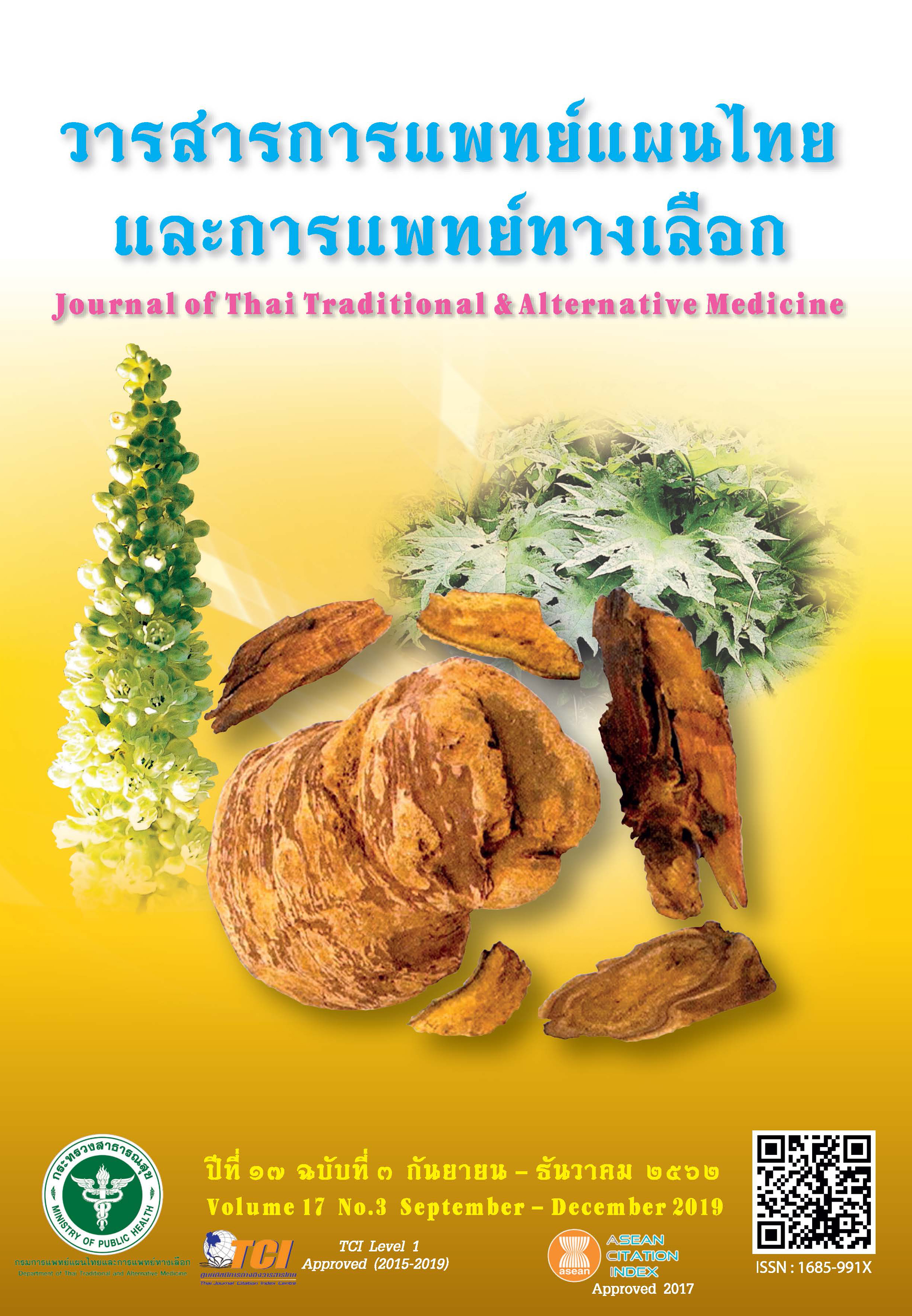The Antioxidant Activities, Total Phenolic, Flavonoid and Melatonin Contents of Five Cultivars of Mulberry Leaves
Main Article Content
Abstract
The objectives of this study aimed to determine antioxidant activities and analysis total phenolic, flavonoid and melatonin contents of five cultivars of mulberry leaves: Buriram 60, Yai-buriram, Sakonnakhon, Khunpai and Srisaket, were harvested from Queen Sirikit Sericulture Center, Khon Kaen in June, 2018. The results showed that Yai-buriram exhibited the highest antioxidant activity on DPPH (IC50 96.17 ± 2.28 μg/ml) and FRAP (163.99 ± 9.26 mmol/100g DW) assays. While, the ABTS radical scavenging assay indicated that Srisaket comprised a good antioxidant activity with IC50 value of 75.24 ± 1.71 μg/ml. With regards to chemical constituents, Buriram 60 showed the highest flavonoid content at 37.19 ± 0.53 mgQE/g, Yai-Buriram showed the highest phenolic content at 390.89 ± 3.90 mgGAE/g DW and melatonin content at 9.77 ± 0.32 μg/g extract. The result obtained implied that the antioxidant activity of mulberry leaf extracts was related with the amount of total phenolic and flavonoid, and melatonin contents.
Article Details
References
main.php?action=viewpage&pid=141. (in Thai)
2. Chang LW, Juang LJ, Wang BS, Wang MY, Tai HM, Hung WJ, Chen YJ, Huang MH. Antioxidant and antityrosinase activity of mulberry (Morus alba L.) twigs and root bark. Food and Chemical Toxicology. 2011;49(4):785-90.
3. Soonthornsit N, Pitaksutheepong C, Hemstapat W, Utaisincharoen P, Pitaksuteepong T. In vitro anti-inflammatory activity of Morus alba L. stem extract in LPSstimulated RAW 264.7 cells. Evidence-Based Complementary and Alternative Medicine. 2017;2017:3928956
4. Kuk E B, Jo A R, Oh S I, Sohn H S, Seong S H, Roy A, Choi JS, Jung HA. Anti-Alzheimer’s disease activity of compounds from the root bark of Morus alba L. Archives of pharmacal research. 2017;40(3):338-49.
5. Surasiang R, Tinchan P, Wiwacharn P, Boonman S, Noppasenee P, Chantarawich S, Sangsiri C, Kajonphol T. Determination of total phenolic compound, antioxidant activity and vitamin c in 8 mulberry leaf lines. Agricultural Sci. J. 2015;46(3):381-4 (in Thai)
6. Samransakul R. Total phenolic and antioxidant activity of mulberry leaves and mulberry tea from some sources in Thailand (dissertation). Bangkok: Chulalongkorn University; 2010.(115).(in Thai)
7. Turumtay E A, Islamoğlu F, Çavuş D, Şahin H, Turumtay H, Vanholme B. Correlation between phenolic compounds and antioxidant activity of Anzer tea (Thymus praecox Opiz subsp. caucasicus var. caucasicus). Industrial Crops and Products. 2014;52:687-94.
8. Daduang J, Daduang S, Hongsprabhas P, Hongsprabhas P, Boonsiri P. High phenolics and antioxidants of some tropical vegetables related to antibacterial and anticancer activities. African Journal of Pharmacy and Pharmacology. 2011;5(5):608-15.
9. Yokoh K, Wesechasat T, Suwannachte P. Phenolic compound of 10 indigenous vegetables from Surat Thani Province. Journal of Thai Traditional & Alternative Medicine. 2018;16(2):185-94 (in Thai)
10. Chen G, Huo Y, Tan D X, Liang Z, Zhang W, Zhang Y. Melatonin in Chinese medicinal herbs. Life sciences, 2003;73(1):19-26.
11. Pothinuch P, Tongchitpakdee S. Melatonin contents in mulberry (Morus spp.) leaves: effects of sample preparation, cultivar, leaf age and tea processing. Food Chemistry. 2011;128(2):415-9.
12. Pothinuch P. Melatonin in mulberry leaves and mulberry leaf tea: Effect of cultivar, leaf ages and tea processing (dissertation). Bangkok: Kasetsart University; 2010. (106). (in Thai)
13. The Queen Sirikit Department of Sericulture. Information about mulberry varieties. Bangkok: Agricultural Cooperatives of Thailand; 2013. 165 P. (in Thai)
14. Arabshahi-Delouee S, Urooj A. Antioxidant properties of various solvent extracts of mulberry (Morus indica L.) leaves. Food Chemistry. 2007;102(4):1233-40.
15. Shalaby E A, Shanab S M. Comparison of DPPH and ABTS assays for determining antioxidant potential of water and methanol extracts of Spirulina platensis. Indian Journal of Geo-Marine Sciences. 2013;42(5):556-64
16. Thaipong K, Boonprakob U, Crosby K, Cisneros-Zevallos L, Byrne D H. Comparison of ABTS, DPPH, FRAP, and ORAC assays for estimating antioxidant activity from guava fruit extracts. Journal of food composition and analysis. 2006;19(6-7):669-75.
17. Um Min, Gyeong-Jin Shin, Jae-Won Lee. Extraction of total phenolic compounds from yellow poplar hydrolysate and evaluation of their antioxidant activities. Industrial crops and products. 2017;97:574-81.
18. Copra-Janićijević A, Culum D, Vidic D, Tahirović A, Klepo L, Bašić N. Chemical composition and antioxidant activity of the endemic Crataegus microphylla Koch subsp. malyana KI Chr. & Janjić from Bosnia. Industrial crops and products. 2018;113:75-9.
19. Kim T K, Kleszczynski K, Janjetovic Z, Sweatman T, Lin Z, Li W, Reiter RJ, Fischer TW, Slominski AT. Metabolism of melatonin and biological activity of intermediates of melatoninergic pathway in human skin cells. The FASEB Journal. 2013;27(7):2742-55.
20. Butkhup L. Dietary polyphenolic and their biological effects. Journal of Science and Technology Mahasarakham. 2012;31(4):443-55 (in Thai)
21. Hochin W. Phytomelatonin and its potential use as a high melatonin functional products (dissertation). Mahasarakham: Mahasarakham University; 2017.(102). (in Thai)

